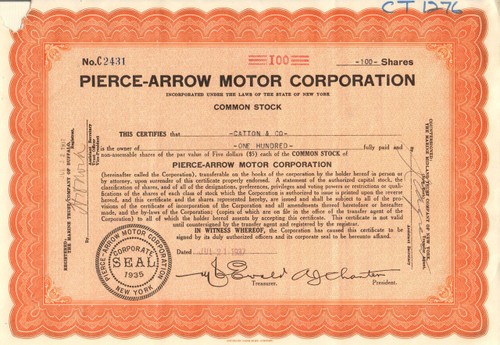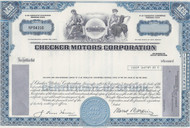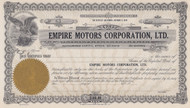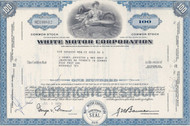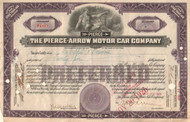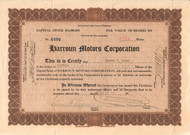Categories
Categories
- Home
- Automotive
- Automakers
- Pierce-Arrow Motor Corporation 1937
Pierce-Arrow Motor Corporation 1937
Product Description
Pierce-Arrow Motor Corporation stock certificate 1937
Rare automotive collectible - not listed in Falater's "American Automotive Stock Certificates". Plain certificate but very desirable certificate of common stock. Issued and cancelled. Piece missing out of upper left corner as shown. Dated 1937, near the end of the company's life.
Pierce-Arrow Motor Car Company was an American automobile manufacturer based in Buffalo, New York, which was active from 1901 to 1938. Although best known for its expensive luxury cars, Pierce-Arrow also manufactured commercial trucks, fire trucks, camp trailers, motorcycles, and bicycles.
In the 1870’s, the George N. Pierce Company produced common household items such as ice chests and birdcages. Pierce used his expertise in metal cage work to transition into the transportation field by manufacturing bicycles.
As demand for improved bicycles grew, Pierce met high demands and industry innovation with the introduction of bicycle advancements such as the cushion frame and coaster brake. In 1901, the company produced its first, one single-cylinder automobile and also had a bicycle display at the Pan-American Exposition. The company continued manufacturing bicycles and motorcycles at this location until 1915.
The George N. Pierce Company became the Pierce-Arrow Motor Car Company in 1908 and began manufacturing larger luxurious automobiles for an affluent market. Pierce-Arrow’s luxury brand was featured in advertisements that were quietly artistic and sophisticated. Pierce-Arrows were marketed as much more than a car. They were symbols of wealth and status.
In 1909, President Howard Taft requested two Pierce-Arrows to serve as official cars of the White House. Pierce-Arrows served as presidential vehicles from Taft to Roosevelt. Foreign royals, diplomats and business tycoons, including John D. Rockefeller, the Shah of Persia, J. Edgar Hoover, the secret service, and many more all drove Pierce-Arrows. Famous Americans like aviation pioneer Orville Wright and hall of fame baseball player Babe Ruth also had Pierce-Arrows in their personal car collections.
While World War I was raging in Europe, the Pierce-Arrow line matured into a lineup of three models that would define the Pierce-Arrow line for a decade. The top of the line was the enormous model 66 with an 825 cubic inch engine. Pierce-Arrow was also involved in the war effort, sending hundreds of trucks from its commercial line to England and France.
In 1928, Pierce-Arrow was bought by Studebaker. This resulted in a number of engineering and design alterations. Studebaker invested money in research and new developments at the Buffalo factory, but investments did not result in sales. Studebaker went bankrupt in 1933, and sold Pierce-Arrow to Buffalo management.
In 1933, Pierce-Arrow unveiled the radically streamlined Silver Arrow in a final attempt to appeal to the wealthy at the New York Auto Show. The car was well received by the public and the motoring press, being announced with the slogan "Suddenly it's 1940!" The bodies were built at Studebaker, which subsequently assisted in rolling out a lower-priced production model. This, however, lacked many luxury features of the show car and still failed to generate enough sales.
The depression years took a toll on the luxury car manufacturers of the country, Pierce-Arrow included. As it became increasingly difficult for Pierce-Arrow to survive as an independent maker of luxury automobiles, the Pierce-Arrow Motor Car Company was reorganized as the Pierce-Arrow Corporation and made a final effort at staying alive with an all new line for 1936. As the final Pierce-Arrow cars were being built, Pierce-Arrow also tried to enter the travel trailer market with the Pierce Travelodge.
 Loading... Please wait...
Loading... Please wait... 
